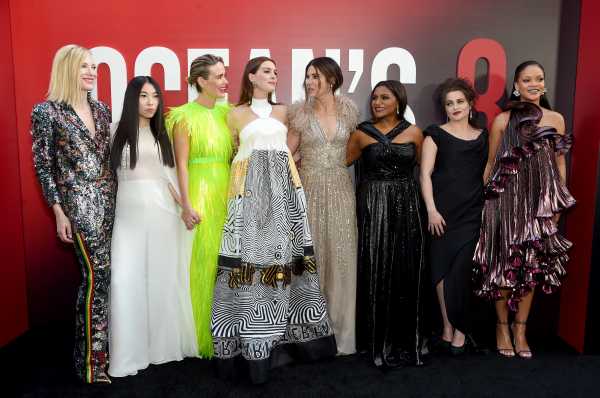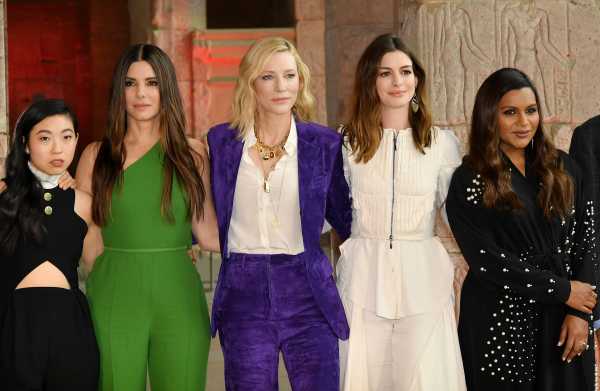
What do film critics even do?
The cast of Ocean’s 8 seems to have some ideas about that question, blaming some of the more tepid reviews their film encountered on male critics who viewed the movie, as Cate Blanchett put it, through a “prism of misunderstanding.” During the film’s press tour, Blanchett, Sandra Bullock, and Mindy Kaling spoke out against gender disparity in not just their own industry — the Hollywood blockbuster business — but in the separate, adjacent field of film criticism, which yet another study showed this week is overwhelmingly white and male.
They’re not wrong about the makeup of the pool of critics. And this discussion about the demographic makeup of film critics is laudable and necessary.

But the way it’s being framed has less helpful implications: that the people whose opinions really count are those whom the movie is “for.” Not only does that ignore how most movies actually make their money, but it says a lot about Hollywood’s attitude toward criticism, best revealed in Blanchett’s statement. She compared studio’s “support” of a film — which means, essentially, a big marketing budget — with critics’ roles in a film’s success, which she says are a “really big part of the equation.”
In that view, critics are mainly useful in how they “support” movies the industry thinks they should like because of the demographic group and audience segment into which they fall.
But that’s not why diversity in criticism is important. If that’s the goal, then it will only succeed in gutting criticism of its richest, fullest potential — something that benefits not just critics but movies and moviegoers too.
To explain all that, it’s important to take a few steps back and understand what critics actually do.
Critics are art makers first
Critics are, themselves, creators of art. It’s an art that’s usually funneled through the medium of journalism, but criticism is still fundamentally an art form.
The art a critic makes is a review or an essay, something that is less about “supporting” a movie and more about drawing on an individual’s experience with a film to make an argument about that movie. It includes evaluation of the film, but it also, done well, is a passionate argument for the importance of art itself.
Often, a great movie review is one that doesn’t require the reader to have seen the movie in order to enjoy it. There’s a reason the legendary New Yorker critic Pauline Kael considered her movie reviews to be her memoir.
Criticism is about expanding a work of art, making it part of a cultural conversation and discourse. It gives it air. It opens it up for the reader to have an experience with it. Criticism is how I take a silly blockbuster like Jurassic World: Fallen Kingdom and write about the implications it has for the idea of human extinction. It’s how I explore how a movie like American Animals or I, Tonya messes with the audience, and what that teaches audiences to expect. It’s how I spin out what a sparing art film like First Reformed is all about.
I’m less interested in telling you whether to go see it — I’m not you, I don’t know what you like — and more interested in working through what the very existence of the movie means. There’s a reason that most critics, if you asked them, would rather you read the review after you see the movie.
This is why criticism needs to be diverse. Critics try to read a film through the lens of their own unique experience, and that gives life to the work of art. Even when we all sit in the same movie theater, we all watch a different work of art. Adding those perspectives to the chorus can only enrich and expand the movie.
Related
“Did we even see the same thing?” How we watched and talked about movies in 2017
Usually, a good critic can tell the difference between their reaction to a film that is due to personal taste and history and a reaction of aesthetic judgment. Good critics are omnivorous, and rarely write off movies simply because of the genre or the intended audience.
In short, a good critic develops a large capacity for imagination. They can’t know what it would be like to see the movie as someone other than themselves. But the good critic tries very hard to put themselves in those shoes anyhow, especially when they detect that the movies’ target audience will be someone other than themselves. And good critics welcome the opinions other critics have about the film.
So in fact, there are some affinities between good critics and good actors, who are celebrated not just for playing versions of themselves but for playing wildly different people than themselves. There are elements of the actor’s craft in the critic’s work.
Diversity in criticism matters because criticism is about the art, not the business

Diversity matters immensely in criticism, for a lot of the same reasons that it matters in Hollywood. One of the biggest reasons that diversity among Hollywood storytellers is worth pursuing is that it expands the kind of stories that can be told and the ways in which they can be told. That leads to a richer art form.
Criticism is a lot like this: It gives us ways to receive a work of art and read it through a number of lenses, each informed by the critic’s own experience.
And criticism is a deeply monolithic industry. The Ocean’s 8 cast’s comments about criticism came around the same time that actress Brie Larson spoke out on the same subject, in connection with a study conducted by USC Annenberg’s Inclusion Initiative. Titled “Critic’s Choice?” the study surveyed 19,559 reviews listed on Rotten Tomatoes for the year’s top 100 films (by box office returns) and found that 77.8 percent of all reviewers were male, and 82 percent of all reviewers were white.
Related
Rotten Tomatoes, explained
But diversifying that pool won’t automatically lead to the results the industry might like. Critics who belong to the same demographic group shouldn’t feel as if they need to move in lockstep with a movie simply because someone like them is represented in it, or because the film’s marketing is aimed at them. Women critics shouldn’t feel as if they need to “support” a film telling a woman’s story, any more than men who want to appear to be feminists should. Black and Latinx and Asian critics shouldn’t be expected to love movies about black and Latinx and Asian people as a matter of course.
As critic Justin Chang recently wrote in the Los Angeles Times, the question “who is this movie for?” is insufficient, especially if one of art’s great functions is to help us imagine and empathize with others’ experiences. “We negate the possibility of sympathetic imagination when we assume that someone’s particular affinity for a work of art will be dictated in advance by specifics of race, gender and age,” Chang writes. “It’s not that those specifics aren’t factors. It’s that some have a tendency to mistake factors for absolutes.”
Reviews and those who write them aren’t meant to “support” a film that hasn’t earned it — not just through its ideas and its characters, but through its writing, its aesthetic choices, and much more. The reason there should be more critics from underrepresented demographics isn’t that they have a higher chance of supporting a film like Ocean’s 8. For one, there are plenty of white men who did like the movie and praised it, a large group you can find easily just by looking at the reviews listed on Rotten Tomatoes.
But more frustratingly, comments like Blanchett’s elide and ignore those women who reviewed Ocean’s 8 and didn’t think it was exactly a masterpiece. Those people included the New Yorker’s Jia Tolentino, Time’s Stephanie Zacharek, New York magazine’s Emily Yoshida, Tribune News Service’s Katie Walsh, and the New York Times’s Manohla Dargis, who notes in her review that “A lot of this is fun to watch but would have been more breezily enjoyable if the movie played as lightly (and seriously) with gender as much as it does with genre.”
All these women critics found that the movie was flawed as a film. It’s more than a representation of women, and it ought not to be praised just for who appears in it, especially if the critic thinks it fails in other ways.
Movie critics don’t work for movie studios
Criticism isn’t about “selling” a film to audiences. Movie critics are not another publicity arm to help the movie business sell its wares. In fact, movie critics don’t belong to the movie industry at all, though we have plenty of interactions with it.
That doesn’t always seem to be the opinion of the movie business, though, as comments from the Ocean’s 8 cast imply. They’re conflating two things: movies as art, and movies as commercial product.
For Hollywood and for the movie business, films are a product to be sold. But movies are not most fundamentally a commercial product. Movies are at core an art form.
That doesn’t mean that they’re not turned into commercial products by companies that are set up to sell tickets or copies of the film. Companies exist to take the work of art and market it, package it, find buyers for it. And filmmakers often make their living playing that commercial game.
But that doesn’t make movies less of an art, just like the culinary arts are still arts whether you’re practicing them at home or in a restaurant kitchen, and paintings are still works of art whether they’re hanging on a wall in a museum for anyone to see or in a Chelsea gallery for a buyer to purchase.

The marketing departments of film studios and distribution companies exist to deal with those commercial aspects of film. But critics have a different job. Critics are primarily interested in the art of the film. That means that critics are looking for things about the film that work or don’t work. They’re interested in the aesthetics and the content. And their main interest isn’t in serving as some kind of Consumer Reports for movies.
People use reviews to figure out whether to go see a movie, of course. But these days, film criticism is often boiled down to a number and fed to an aggregator like Rotten Tomatoes, and that’s what audiences are interested in — not an argument or a piece of writing. And since Rotten Tomatoes was acquired by the ticket-selling site Fandango, the Rotten Tomatoes score shows up directly on Fandango’s website. (Whether that score influences ticket sales is a complicated matter, but in some cases, it almost certainly has an effect.)
Critics generally tolerate Rotten Tomatoes because it can drive traffic toward a review, and in this economy, traffic is how most writers make a living. But the reason people go into film criticism is that they love movies, and they want to talk about them and write and think about them and explore them. They want to open up a work of art, to treat it respectfully and seriously when it allows them to do so, and to make space for the audience to have their own experience with the film.
The fact that a movie has content that the critic agrees with or characters that look like the critic doesn’t mean it’s a good movie. And just because a movie is marketed to a particular audience, there’s no guarantee it will be successful in speaking to that audience. Critics who belong to that audience segment are not automatically going to love it.
In fact, ideally, black women critics would be reviewing movies primarily aimed at white men, and vice versa. It’s as much of a tragedy that there were so few underrepresented critics reviewing The Post as it is there were so few reviewing Moonlight. Criticism isn’t an arm of the studio publicity machine that can convince people they should go see a movie because a bunch of people like them liked it. Instead, it should challenge and prod and celebrate an art form that has the potential to tell all kinds of stories about all kinds of people.
Further complicating the notion is the fact that big Hollywood movies depend on attracting many kinds of viewers. Unlike more niche genre films, prestige dramas, and offbeat independent films, which may aim themselves at narrower demographic segments, blockbusters like Ocean’s 8 traffic expressly in the idea that they’ll be able to sell tickets to a wide variety of people, recoup their big budgets, and then make a lot more money too.
So it doesn’t naturally follow, as Blanchett said, that a middle-aged white guy would see Ocean’s 8 through a “prism of misunderstanding.” He’s part of the intended audience. He has to be, just like Wonder Woman had to attract more than women to the theater to become a massive blockbuster success.
The biggest obstacles to diversifying the critical pool lie with those who make the decisions in media and at the movie studios
Recognizing that criticism doesn’t exist to prop up movie studios doesn’t fix the larger issue, though — something Larson clarified in her comments. “What I am saying is that if you make a movie that is a love letter to women of color,” she said, “there is an insanely low chance a woman of color will have the chance to see your movie and review your movie. We need to be conscious of our bias and make sure that everyone is in the room.”
That’s inarguably correct. There just aren’t that many women critics. There also aren’t many critics of color. And there are very few women critics of color — only 8.9 percent of the critics in Annenberg’s study were women of color, compared to 53.2 percent white men, 23 percent white women, and 14.8 percent men of color.

That means that the slice is already very small, and it’s even more difficult given one big issue: the way studios grant access to press screenings and junkets to critics and journalists.
Nearly any critic in a major market (typically New York or Los Angeles) has stories of woe about gaining access to screenings of big studio releases. (Smaller and independent movie distributors often hire outside firms to publicize their movies that have a good sense of the landscape — and those are typically less of a problem since for many of them, any press helps boost their movie’s profile.) Divining what studios believe about press and movie audiences is a real challenge, but a couple of things are clear to anyone who’s spent time working in those markets.
First of all, even in 2018, studios still typically prioritize print outlets over digital ones, even though the potential for an actual printed review to reach a lot of people is relatively low. (Most print outlets have a website for this reason.) But an old-school perception persists that print means prestige, and that means that writers working for digital-only outlets are often shut out of early screenings, and sometimes out of all but one or two later screenings. That can make it tough for some critics to even see a movie in time to write about it — especially if studios happen to schedule their screenings on the same night, or if the screening is scheduled on the same night as, say, your child’s birthday party.
This especially affects freelance critics and those at the lower end of the pay scale — print publications typically pay more than their digital cousins, and most use fewer freelancers — and if you’re guessing that most underrepresented critics are not at print outlets, you’re right.
There’s also a second reason. I’ve written about how the perception still persists — even after much evidence to the contrary — that movies starring women and people of color are for “niche” audiences. At first blush, that might seem like a boon for critics who represent those groups. But what seems to be true is that the studios also perceive critics who belong to those groups as niche too.
While it’s anecdotal, some critics — especially women of color — report having particularly difficult times getting into screenings.
Related
Black Panther crushed overseas sales projections. Can we stop saying “black films don’t travel”?
Hollywood’s ideas about audiences are outdated. Wonder Woman’s record-smashing debut proves it.
“Part of the reason why critics of color can’t review more movies is because they’re denied accreditation or access to screenings,” Latina critic Monica Castillo wrote following the release of the study. “Invitations to advance screenings don’t usually find their way to underrepresented journalists and critics’ inboxes as easily as they do others.”
And an editorial about Larson’s statements at the pop culture site Black Girl Nerds, which reports from festivals around the world and is listed on Rotten Tomatoes, noted that its publication has “had its fair share of pushback from publicists,” citing being “ghosted from studio publicists when it comes to set visit opportunities and press junkets.”
Importantly, the BGN site notes, this “sadly shuts out not only opportunities for more diverse voices to be heard within the pop-culture criticism industry” but also “shuts out the chance for Black women journalists to get the experience to report and to use those skills to work for larger publications.”
So when Bullock suggests that gender disparity in criticism can be overcome by “balancing out the pool of critics so it reflects the world we live in,” she’s right on the money. The onus for this doesn’t primarily lie, as Meryl Streep once claimed (and Kaling referenced), on Rotten Tomatoes, which aggregates reviews. It lies on the (shrinking number of) companies that hire critics.
But companies aren’t going to hire more critics if aggregators like Rotten Tomatoes keep cutting the legs out from under the critics who craft reviews. Media companies, for better or worse, make their decisions based on traffic — and when audiences rely on a simple, flawed score instead of actual reviews, it cuts down on the number of critics who will likely be hired in the future.
Ask most critics about what they wish audiences would do when it comes to movies and they’ll give you a similar answer: They wish audiences would read more critics instead of relying on aggregators like Rotten Tomatoes, which serve up imperfect data that strips out the individuality of each critic’s experience with the art and tends to flatten the craft of criticism altogether.
Instead, critics wish that audiences would locate a few film writers to read consistently: a few whose taste seems to match their own, and a few who consistently run contrary to their instincts in order to help expand their palate.
And just as importantly, while diversity is absolutely something that will improve not just the craft of criticism but the overall dialogue around a film, the idea that diversifying criticism will help prop up mediocre studio fare is just another way of making critics de facto marketers. The best reason to diversify criticism is so that when Hollywood puts out movies for women, or movies for people of color, it doesn’t get lazy. The movie business can’t be allowed to commodify diversity for its own ends.
What’s needed, in the end, is more mixed reviews.
Sourse: vox.com






